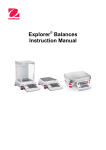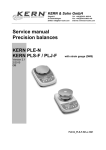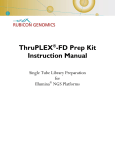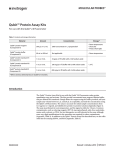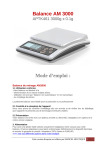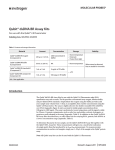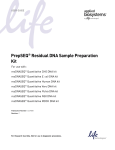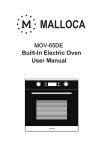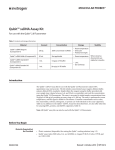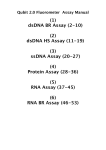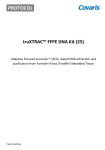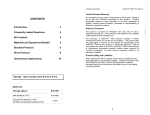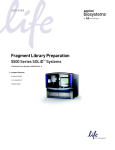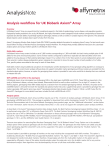Download FFPE DNA extraction protocol
Transcript
E FFPE DNA Extraction Protocol for OncoScan™ Assay NOTE: Affymetrix strongly recommends using the QIAamp DNA FFPE Tissue Kit protocol for purifying DNA from FFPE Blocks that will be used in OncoScan™ Assay. For improved DNA yields, we also recommend a modification to the QIAamp DNA FFPE Tissue Kit protocol. The modified procedure adds a heating step at 98 °C for 15 minutes to improve the tissue digestion process to release DNA from tissue sections Please refer to the QIAamp DNA FFPE Tissue Kit protocol for more information on the QIAGEN web page given below. http://www.qiagen.com/Products/Catalog/Sample-Technologies/DNA-Sample-Technologies/GenomicDNA/QIAamp-DNA-FFPE-Tissue-Kit#resources Equipment and Reagents Required, but not Provided with OncoScan™ FFPE Assay Kit When working with chemicals, always wear a suitable lab coat, disposable gloves, and protective goggles. For more information, consult the appropriate material safety data sheets (MSDSs), available from the product supplier. Equipment Required Table E.1 Equipment Required Equipment Vendor P/N Microtome (HM340E Electronic Rotary Microtome Package, with Universal Cassette Clamp and Disposable Blade Carrier E (ThermoFisher Cat#: 905190A)) VWR International 89219-568 Vortex Genie 2 (G560) VWR International 58815-234 Microcentrifuge, 5424 (EPPE022620401) VWR International 80094-126 Thermomixer R (22670107) (Qty Required: 2) VWR International 21516-166 Block for 24 x 1.5 mL Tubes for Thermomixer R (22670522) (Qty Required: 2) VWR International 21516-176 Pipet-Lite LTS Pipette, Single Channel, 0.5-10 μL Rainin L-10 Pipet-Lite LTS Pipette, Single Channel, 20-200 μL Rainin L-200 Pipet-Lite LTS Pipette, Single Channel, 100-1000 μL Rainin L-1000 Pipet-Lite LTS Pipette, 12-Channel, 2-20 μL Rainin L12-20 Appendix E | FFPE DNA Extraction Protocol for OncoScan™ Assay 121 Consumables Required Table E.2 Consumables Required Equipment Vendor P/N Fischer Scientific 3153735 Eppendorf tubes, 1.5 mL microcentrifuge tubes VWR International 022363204 Non-Stick RNase-free Microfuge Tubes (1.5 mL) Life Technologies AM12450 Greenpak LTS 20 μL Filter Tip, 960 Tips Rainin GP-L10F Greenpak LTS 200 μL Filter Tip, 960 Tips Rainin GP-L200F Greenpak LTS 1000 μL Filter Tip, 768 Tips Rainin GP-L200F VWR 82006-636 HP-35 High-Profile blades with PTFE coating VWR PCR Plate, 96-Well, Flat Plate Reagents Required Table E.3 Reagents Required Equipment Vendor QIAamp DNA FFPE Tissue Kit QIAamp MinElute Columns Collection Tubes - 2 mL Buffer ATL Proteinase K Buffer AL Buffer AW1 Buffer AW2 Buffer ATE QIAGEN P/N 56404 1020901 1016810 1014758 19133 1014604 1014790 1014592 1049476 Xylene Sigma Aldrich 534056-500ML Ethanol (96-100%) Sigma Aldrich 459836 QIAGEN 1007885 RNase A Optional Prerequisite The yield of tissue from FFPE is highly dependent on the type of tissue and method used for the initial fixation. For optimal DNA yield, samples submitted for extraction should have a tissue size of 400-700 square mm. Preparation of Buffers Preparing Buffer ATL Check whether precipitate has formed in Buffer ATL. If necessary, dissolve by heating to 70 °C with gentle agitation. Preparing Buffer AL Check whether precipitate has formed in Buffer AL. If necessary, dissolve by heating to 70 °C with gentle agitation. Appendix E | FFPE DNA Extraction Protocol for OncoScan™ Assay 122 Preparing Buffer AW1 Add 25 mL ethanol (96-100%) to the bottle containing 19 mL Buffer AW1 concentrate. Can be stored in room temperature up to 1 year. Preparing Buffer AW2 Add 30 mL ethanol (96-100%) to the bottle containing 13 mL Buffer AW2 concentrate. Can be stored in room temperature up to 1 year. Deparaffinization 1. From an FFPE block, prepare 10 micron slices. Place 5 slices in a 1.5 mL Eppendorf Safe-Lock Tube. NOTE: The Eppendorf Tubes must have the centrifugation stability of up to 30,000 x g to prevent tube breakage. Please refer to the consumables list. 2. Turn on two thermal mixers. Set one to 56 °C and the other to 98 °C. 3. Add 1 mL of Xylene to the tube. 4. Vortex the tube at max speed for 10 seconds. 5. Spin down the tube at full speed (~14000 rpm) for 5 minutes. 6. Without disturbing the pellet remove the Xylene. NOTE: Be sure to place waste Xylene in the appropriate container. 7. Add 1 mL of Ethanol to the tube. 8. Vortex the tube at max speed for 10 seconds. 9. Spin down the tube at full speed (~14000 rpm) for 5 minutes. 10. Without disturbing the pellet remove the Ethanol by using a P1000 pipette. NOTE: Be sure to place waste Ethanol in the appropriate container. 11. Repeat Step 7 through Step 10 once more. 12. Spin down the tube at full speed (~14000 rpm) for 3 minutes. 13. Use a p20 or P200 pipette to completely remove any residual Ethanol without disturbing the pellet. 14. Allow any remaining Ethanol to evaporate by letting the tube air dry for 10 minutes at room temperature. Tissue Lysis 1. Add 180 µL of ATL Buffer to the tube after ensuring the residual ethanol has completely evaporated. 2. Vortex at full speed for 10 seconds. 3. Spin down the tube briefly and then place it onto the thermal mixer that is set at 98 °C. 4. Incubate the tube for 15 minutes with a 15 second mix at 1400 rpm every 1 minute. NOTE: Thermomixer settings: Ensure the thermomixer is programmed to shake the samples for 15 sec after each minute at 1400 RPM. 5. After 15 minutes, stop the thermomixer program and turn off the thermomixer. Let the tube cool down for 5 minutes in the thermomixer before removing them. This is to ensure the vials do not pop open due to high heat and pressure. 6. Remove the tube carefully and slowly (as they may still pop open) from the thermal mixer and allow it cool at room temperature for 10 minutes. 7. Spin down the tube to remove any solution from the top of the tube. Appendix E | FFPE DNA Extraction Protocol for OncoScan™ Assay 123 8. Add 20 µL of Proteinase K to the tube. 9. Vortex the tube at max speed for 10 seconds, then spin down briefly. 10. Place tube on the thermal mixer that is set at 56 °C. 11. Incubate the tube for at least 3.5 hours with a 15 second mix at 1400 rpm every 1 minute. 12. After 3.5 hours, verify that all tissue has lysed. A. If tissue remains, incubate the samples overnight. If tissue still remains, add an additional 20 µL of Proteinase K and continue incubation for a minimum of 1 hour. 13. Spin down the tube and place them onto the thermal mixer that is set at 90 °C. 14. Incubate the tube for 1 hour with a 15 second mix at 1400 rpm every 1 minute. NOTE: Thermomixer settings: Ensure the thermomixer is programmed to shake the samples for 15 sec after each minute at 1400 RPM. 15. After 1 hour, remove the tube from the thermal mixer and allow to cool at room temperature for 10 minutes. 16. Spin down the tube to remove any solution from the top of the tube. 17. Add 2 µL of RNase A to each tube. 18. Vortex the tube at max speed for 10 seconds, then spin down briefly. Allow to incubate for 2 minutes. DNA Purification 1. Remove a QIAamp MinElute column from the refrigerator and allow to warm to room temperature for 15 minutes. 2. Remove the ATL tube and equilibrate at room temperature. 3. Add 200 µL of Buffer AL to the sample tube, vortex at max speed for 10 seconds, then spin down briefly. A. If processing multiple samples, ensure that after adding Buffer AL, Ethanol is added as quickly as possible. B. Precipitate may form at this step, which does not affect the DNA yield. 4. Add 200 µL of Ethanol to each tube, vortex at max speed for 10 seconds, then spin down briefly. 5. Label the QIAamp MinElute column (in a 2 mL collection tube) appropriately. 6. Carefully transfer the entire lysate to the QIAamp MinElute column (in a 2 mL collection tube) without wetting the rim, close the lid, and centrifuge at 6000 x g (8000 rpm) for 1 min. A. Check to see that all the lysate has moved through the column. If lysate is still in the column centrifuge again at a higher speed for 1 minute. 7. Place the column into new collection tube and discard eluate. 8. Open the column and add 500 µL of Buffer AW1. 9. Load the column onto the centrifuge and spin at 8000 rpm (6000g) for 1 minute. A. Check to see that the entire Buffer AW1 has moved through the column. If Buffer AW1 is still in the column centrifuge again at a higher speed for 1 minute. 10. Place the column into new collection tube and discard eluate. 11. Open the column, and add 500 µL of Buffer AW2. 12. Load the column onto the centrifuge and spin at 8000 rpm (6000g) for 1 minute. A. Check to see that the entire Buffer AW2 has moved through the column. If Buffer AW2 is still in the column centrifuge again at a higher speed for 1 minute. 13. Place the column into new collection tube and discard eluate. 14. Load the column onto the centrifuge and spin at 14000 rpm (20000g) for 3 minutes to dry the membrane completely. Appendix E | FFPE DNA Extraction Protocol for OncoScan™ Assay 124 DNA Elution 1. Label a clean Nuclease-free 1.5 mL tube for DNA elution. 2. Place the column into the labeled 1.5 mL tube prepared for elution. 3. Add 50 µL of Buffer ATE to the center of the column membrane. 4. Close the lid and incubate the column at room temperature for 5 minutes. 5. Load columns onto the centrifuge and spin at 14000 rpm (20000g) for 1 minute to elute the DNA. A. Note: Caps for 1.5 mL tube will not be able to close at this step due to the columns. When loading onto the centrifuge rotate caps to the right to keep them from breaking during the spin. B. When eluting multiple samples, alternate positions in centrifuge to make room for caps. Quantitation of Eluted FFPE DNA 1. Perform either of the two Affymetrix recommended and tested dsDNA quantitation protocols that are included in the user manual, to measure the concentration of the eluted FFPE DNA. Affymetrix strongly recommends using these protocols that have been tested at Affymetrix using the following kits for DNA quantitation. ® ™) Quant-iT™ PicoGreen dsDNA Assay Kit (Catalog Number: P7589, LifeTechnologies ® ™ Qubit dsDNA HS Assay Kit (Catalog Number: Q32851, LifeTechnologies ) 2. Record the results and the volume information in a spreadsheet.






